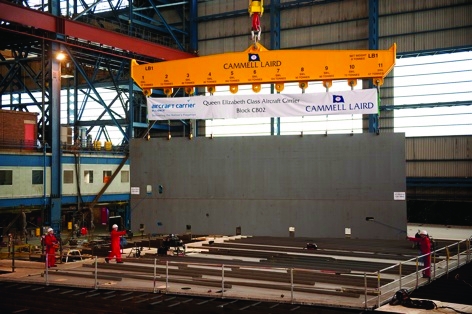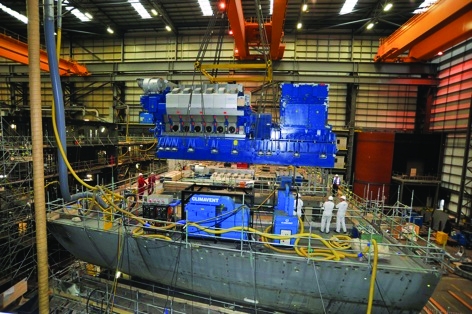On 26th July I visited the Cammell Laird shipyard at Birkenhead for the official start of construction of the flight deck. At a ceremony in the recently refurbished build hall, the first plate making up the flight deck structure was formally lowered into position on the push of a button by the Minister for International Security Strategy, Gerald Howarth MP. This was a very significant event for the Aircraft Carrier Alliance as it means that construction is now underway at all six of the UK shipyards working on the programme. I worked occasionally at Cammell Laird over 20 years ago when they were building the Upholder Class submarines but since that the yard fell on some hard time, in fact briefly closing, so it was great to see the facilities re-furbished and working once again. The enthusiasm of the Cammell Laird workforce, especially the apprentices who attended the ceremony was great to see.

Meanwhile at Portsmouth on the 31st July the forward diesel generators were installed onto their seats in Lower Block 02. This was a very carefully planned operation and achieved as a single lift for each diesel generator, which has saved a considerable amount of time and a similar strategy will be employed for installing the larger aft diesel generators into the aft engine room at Govan in Scotland. Once the diesel generators were installed the shipyard workers have lost no time in continuing to outfit the machinery spaces with pipes, valves, pumps etc. and the forward engine room is certainly starting to take shape. More large steelwork assemblies are being prepared to close off the engine room and then make preparations for the installation of the High Voltage switchboards in the autumn. The transition from CAD model on computer screens to real hardware that can be seen and touched is gaining momentum, the fruition of years of hard work by the designers and engineers.

A unique feature of the design of the QE Class is the twin island configuration. The advantages of this are that it simplifies the uptake and downtake arrangements for the Gas Turbine Alternators which are located directly below both islands. It also enables the ship control facilities, such as the navigation etc. to be concentrated in the forward island with a good view forward and over the bow, while the flight control (FLYCO) and aviation control facilities are located in the aft island close to the business end of the flight deck where the aircraft will start their take off run. A result of this unique design is an equally unique antenna arrangement which provides the QE Class with an extremely powerful and capable communications fit. To test out how this densely packed equipment will perform to achieve Air Traffic Control a replica of the aft island and critical areas of the upper deck has been built at BAE Systems at Cowes on the Isle of Wight. A rigorous test programme is underway and to date it has demonstrated that the communications mast and the Medium Range Radar are able to work together with no adverse impact on the Air Traffic Control performance of the radar. This is a significant step in de-risking the integration of the same equipment onto the actual ships.
Thank you for the comments received on my last posting, I should perhaps clarify one point. The design of the aircraft carriers is intentionally adaptable to allow them to fulfil a wide variety of roles and to embark a number of different aircraft type both rotary and fixed wing. They will be configured with a take off ramp and runway for operation with Short Take Off Vertical Landing (STOVL) aircraft such as the Harrier GR9 and the F35B, the STOVL variant of the Lightning 2 Joint Strike Fighter. The ship design does however have the space and facilities so that it could, at a later date be converted to carry steam or electromagnetic catapults, an angled flight deck and arrestor wires enabling operation with conventional carrier borne aircraft. Equally this adaptability could be used to carry a variety of helicopters and vehicles to carry out disaster relief or support amphibious operations. As a result of their size the number of roles that these ships could carry out in support of our armed forces anywhere in the world is considerable.










Water Sector Talent Exodus Could Cripple The Sector
Maybe if things are essential for the running of a country and we want to pay a fair price we should be running these utilities on a not for profit...